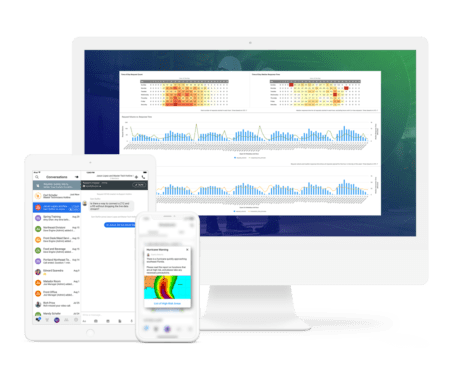Today there is an ever-growing number of team communication apps to choose from — and for good reason. Real-time communication is essential for collaboration and knowledge sharing, especially as workforces become more dispersed across cities, states and countries.
To help you find the right app for your team, we’ve put together 5 five key factors to consider when evaluating your options.
1. Ease of Use
Your company most likely employs people of various age-groups, each with their own technology comfort levels and work habits. Navigating these differences means finding an app that is familiar and easy to use. Without high adoption, you won’t be able to leverage the true value of real-time communication.
Ease of use on mobile is particularly important for frontline workers who rely on mobile devices on the job and don’t have the time to deal with complicated apps. Despite the popularity of team chat tools such as Slack and Microsoft Teams – which offer mobile versions for iOS and Android – these apps don’t meet the needs of frontline workers who prefer a simple interface. This has resulted in the proliferation of consumer apps like WhatsApp in the workplace, raising big administration, control, visibility and data concerns for the enterprise.
2. Multiple Modes of Communication
 Not every app supports every mode of communication. There are intranets, video conferencing apps, instant messaging apps, walkie-talkie apps, employee alert systems; the list goes on. The problem? Teams need to communicate in a variety of modes and it’s frustrating when you have to juggle multiple apps, especially if you are a frontline worker.
Not every app supports every mode of communication. There are intranets, video conferencing apps, instant messaging apps, walkie-talkie apps, employee alert systems; the list goes on. The problem? Teams need to communicate in a variety of modes and it’s frustrating when you have to juggle multiple apps, especially if you are a frontline worker.
The best team communication software combines multiple modes of communication into one platform to create a seamless experience for communication and collaboration. With Zinc Real-Time Communication, teams can choose from messaging, voice and video calls, video and image sharing, hotline groups and even one-to-many Broadcasts. No matter what device your employees are on, they can choose the best mode of communication for their needs.
3. Powerful Group Capabilities
Effective team communication apps organize conversations into manageable groups. Groups allow you to keep conversations focused on a specific topic with all the right people. Typically, each team or department will have its own group, as well as groups for specific projects and events as well as a few fun social groups.
Key group features to look for are the ability to:
- Sync with your corporate directory to generate groups that match your company structure
- Mute conversations that aren’t critical
- Create open groups that anyone can join, as well as closed groups
- Share files and start conference calls from any group
- Search for old conversations and files
- Bring people together for short-term ad-hoc conversations
These group messaging capabilities make it easy to collaborate in real time while staying organized.
4. Administration
It’s crucial for your team communication app to provide central administration so you can easily manage groups, provision users and set data management policies. Administrative power is a significant differentiator between enterprise apps and consumer apps. With proper administration, you have control over your data, can ensure the platform is configured to meet your needs and most importantly, you can immediately remove all access to the app and it’s data when employees leave the company.
5. Workflow Integrations
The best team communication apps allow you to communicate in the context of work being done. Integrations into key workflow systems allow for a seamless experience that doesn’t require users to bounce between platforms while collaborating.
Key integrations include:
- Content Management apps like Google Drive and Dropbox
- Field Service Management systems like ServiceMax, Oracle Field Service, or ClickSoftware
- Customer Relationship Management software like Salesforce
Finding the Right Team Communication App
Real-time communication is essential in the workplace and finding the right tool can make or break your team’s productivity. Use these factors to differentiate the never-ending number of team communication apps on the market and find the best fit for your team.


Share this: